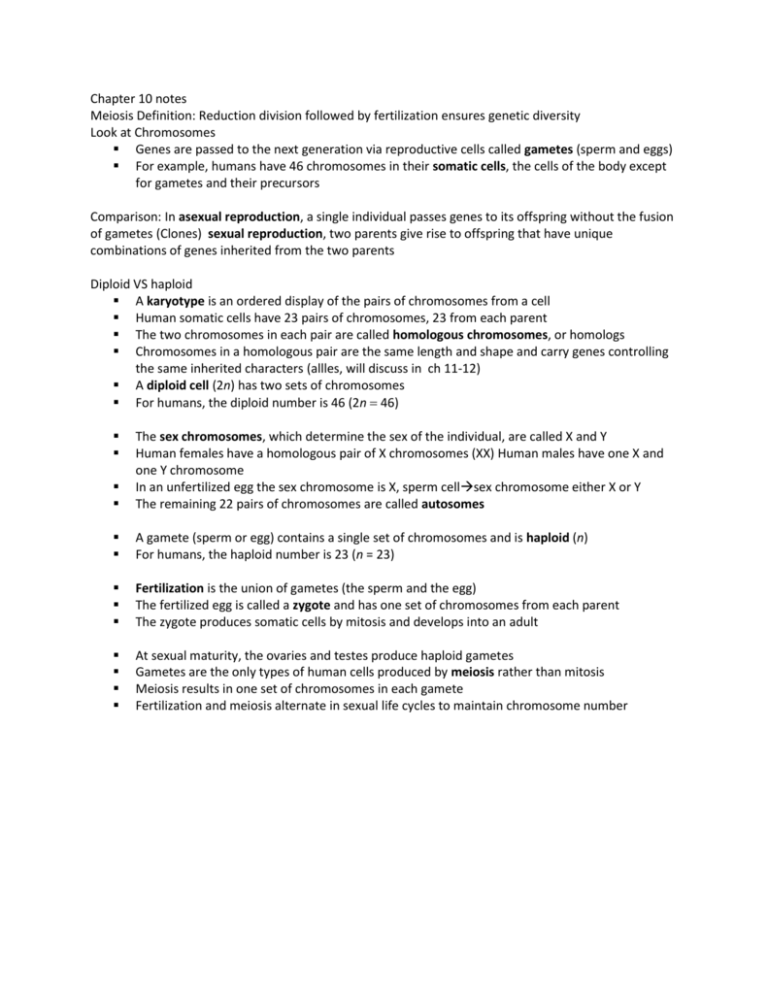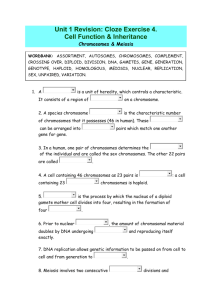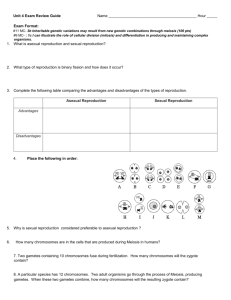Chapter 10 lecture notes
advertisement

Chapter 10 notes Meiosis Definition: Reduction division followed by fertilization ensures genetic diversity Look at Chromosomes Genes are passed to the next generation via reproductive cells called gametes (sperm and eggs) For example, humans have 46 chromosomes in their somatic cells, the cells of the body except for gametes and their precursors Comparison: In asexual reproduction, a single individual passes genes to its offspring without the fusion of gametes (Clones) sexual reproduction, two parents give rise to offspring that have unique combinations of genes inherited from the two parents Diploid VS haploid A karyotype is an ordered display of the pairs of chromosomes from a cell Human somatic cells have 23 pairs of chromosomes, 23 from each parent The two chromosomes in each pair are called homologous chromosomes, or homologs Chromosomes in a homologous pair are the same length and shape and carry genes controlling the same inherited characters (allles, will discuss in ch 11-12) A diploid cell (2n) has two sets of chromosomes For humans, the diploid number is 46 (2n 46) The sex chromosomes, which determine the sex of the individual, are called X and Y Human females have a homologous pair of X chromosomes (XX) Human males have one X and one Y chromosome In an unfertilized egg the sex chromosome is X, sperm cellsex chromosome either X or Y The remaining 22 pairs of chromosomes are called autosomes A gamete (sperm or egg) contains a single set of chromosomes and is haploid (n) For humans, the haploid number is 23 (n = 23) Fertilization is the union of gametes (the sperm and the egg) The fertilized egg is called a zygote and has one set of chromosomes from each parent The zygote produces somatic cells by mitosis and develops into an adult At sexual maturity, the ovaries and testes produce haploid gametes Gametes are the only types of human cells produced by meiosis rather than mitosis Meiosis results in one set of chromosomes in each gamete Fertilization and meiosis alternate in sexual life cycles to maintain chromosome number Phases of Meiosis (how do we get Gametes?) For a single pair of homologous chromosomes in a diploid cell, both members of the pair are duplicated In the first meiotic division, homologous pairs of chromosomes pair and separate In the second meiotic division, sister chromatids of each chromosome separate Four new haploid cells are produced as a result In crossing over, non-sister chromatids exchange DNA segments At the end of meiosis, there are four daughter cells, each with a haploid set of unduplicated chromosomes Each daughter cell is genetically distinct from the others and from the parent cell Meiosis reduces the number of chromosome sets from two (diploid) to one (haploid), producing cells that differ genetically from each other and from the parent cell Three mechanisms contribute to genetic diversity -Originates with mutations which are passed on through sexual reproduction Independent assortment of chromosomes: Homologous pairs of chromosomes orient randomly at metaphase I of meiosis AND In each pair of chromosomes sorts maternal and paternal homologs into daughter cells independently of the other pairs The number of combinations possible when chromosomes assort independently into gametes is 2n, where n is the haploid number. For humans (n = 23), there are more than 8 million (223) possible combinations of chromosomes. Crossing over: begins in prophase I, as homologous chromosomes pair up gene by gene homologous portions of two nonsister chromatids trade places Crossing over contributes to genetic variation by combining DNA, producing chromosomes with new combinations of maternal and paternal alleles Random fertilization adds to genetic variation because any sperm can fuse with any ovum The fusion of two gametes (each with 8.4 million possible chromosome combinations from independent assortment) produces a zygote with any of about 70 trillion diploid combinations Crossing over adds even more variation Each zygote has a unique genetic identity Evolution Natural selection results in the accumulation of genetic variations favored by the environment Sexual reproduction contributes to the genetic variation in a population, which originates from mutations Asexual reproduction is less expensive than sexual reproduction Nonetheless, sexual reproduction is nearly universal among animals Overall, genetic variation is evolutionarily advantageous









